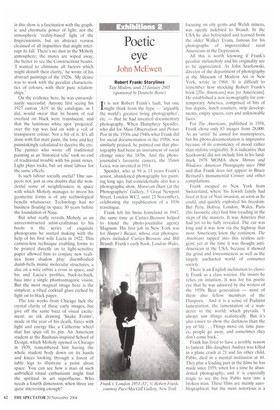Light entertainment
Laura Gascoigne
Laszlo Moholy-Nagy: A Life in Motion Annely Juda Fine Art, 23 Den'ng Street, London WI, until 18 December
If you were looking for someone to blame for the explosion of multi-disciplinarity in contemporary art, Laszlo Moholy-Nagy would be a likely suspect. In a 30-year career that took him from Budapest in 1919 to Vienna, Berlin, Weimar, Amsterdam, London and Chicago — where he died of leukaemia in 1946, aged 51 — this self-taught, Hungarian-born Constructivist ticked an awful lot of disciplinary boxes. Painter, collagist, graphic artist, stage and set designer, experimental photographer and filmmaker, the man who gave the world the kinetic 'Light Space Modulator' also pioneered the use of transparent plastics in sculpture — thus hastening the art form's 'dernaterialisation'. (Sadly, most of his sculptures have dematerialised, as the early forms of Perspex he cooked up on his kitchen stove were unstable. Don't try this at home.)
A 1977 replica of his 'Plexiglass Spirals' from 1946 is the only sculpture among the 50 works in the exhibition Laszlo MoholyNagy: A Life in Motion — Paintings, Sculpture, Drawings and Photography at Annely Juda. The artist's first major show in Britain since 1980, it's a salutary reminder of the yawning gulf between the committed experimentalism of the early Modernists and the sampling culture of the Postmodern 'slacker' generation. As the young Moholy, who had taken up art after being invalided out of the AustroHungarian army, wrote in his diary in May 1919: 'Can I assume the privilege of becoming an artist for myself, when everybody is needed to solve the problems of simply managing to survive?'
For the generation that lived through the first world war, art was, to all intents and purposes, a luxury. It urgently needed new intents and purposes to justify its existence, and it found them in an identification with technology.
In the effort to square his art practice with a social conscience, Moholy became a notorious opponent of the spiritual in art. His declared mission, as a teacher at the Bauhaus in the 1920s, was to replace the 'personal touch' with a 'machine-like precision', in the cause of toppling bourgeois art from its pedestal and ushering in the Constructivist age of 'the socialism of vision'. If this sounds grim in theory, it was rather different in practice. As this show reveals, Moholy's 'socialism of vision' was not so very far removed from Ingres"pro
bity of art' both were founded in drawing, the difference between them being that Moholy's preferred drawing medium was light.
The link between the multifarious works in this show is a fascination with the graphic and chromatic power of light: not the atmospheric 'reality-based' light of the Impressionists, but an abstract version cleansed of all impurities that might interrupt its fall. There's no dust in the Moholy atmosphere; the motes are wiped away, the better to see the Constructivist beams. 'I wanted to eliminate all factors which might disturb their clarity,' he wrote of his abstract paintings of the 1920s. 'My desire was to work with the peculiar characteristics of colours, with their pure relationships.'
On the evidence here, he was extraordinarily successful. Anyone first seeing his 1927 canvas 'A19' in the catalogue, as I did, would swear that its beams of red overlaid on black were translucent, and that the luminous white spot 'projected' over the top was laid on with a veil of transparent colour. Not a bit of it. It's all done with flat matt paint, the tone and key painstakingly calculated to deceive the eye. The painter who wrote off traditional painting as an 'historical relic' took no end of traditional trouble with his paint mixes. Light plays tricks, but art must labour for the same effects.
Is such labour socially useful? One suspects not, just as one doubts that the wonderful sense of weightlessness in space with which Moholy manages to invest his geometric forms is of any technological benefit whatsoever. Technology had no business floating in space 30 years before the foundation of Nasa.
But what really reveals Moholy as an unreconstructed artist-craftsman to his boots is the series of exquisite photograms he started making with the help of his first wife Lucia in 1922. This camera-less technique enabling forms to be printed directly on to light-sensitive paper allowed him to conjure new realities from shadow play: disembodied dumb-bells mimic molecular structures, a disc on a wire orbits a cross in space, and his and Lucia's profiles, back-to-back, fuse into a single phantasmagoric vision. But the most magical image here is the simplest: a tilted cocktail glass etched by light on to black paper.
The late works from Chicago lack the crystal clarity of these early images, but give off the same buzz of visual excitement: an ink drawing 'Snake Forms', made in the year of his death, fizzes with light and energy like a Catherine wheel that has spun off its pin. An American student at the Bauhaus-inspired School of Design, which Moholy opened in Chicago in 1939, remembered him having the whole student body down on its hands and knees looking through a forest of table legs to illustrate a point about space. You can see how a man of such unbridled visual enthusiasm might find the spiritual in art superfluous. Who needs a fourth dimension, when three are quite interesting enough?



























































































 Previous page
Previous page